About
Eclipse Soils specialises in finding innovative solutions to enable materials to be beneficially re-used and recycled rather than simply disposed of to landfill.
Eclipse Soils is the “go to” organisation to deal with acid sulfate soils, hydrocarbon and certain pesticide impacted soils, and other challenging problem materials.
Diversion from landfill is generally environmentally beneficial and where it meets the principles of sustainability it is generally a highly desirable outcome for society.
Eclipse has an inhouse team of highly experienced Environmental Scientists, and where required, also draws expertise externally from some of Australia’s leading Environmental Scientists. The Company operates under all requisite licenses primarily issued by the Department of Water and Environmental Regulation.
Eclipse Soils processes and remediates materials to produce a range of products, primarily:
- Water retentive soils and mulches for the landscape industry, public open space (e.g. local government) and private recreational areas;
- Phosphorus retentive filter media and other products to prevent phosphorus entering ground water and water ways leading to eutrophication; and
- Geotechnically suitable fill products for the land development and building industry, including for the development of residential and industrial subdivisions from former sand and limestone quarries in line with the National and the State of Western Australia Sequential Land Use Policy.
These products are covered in detail in Eclipse Soils’ Product Catalogue and Product Use Guidelines.
We invite you to contact Eclipse Soils to discuss the most cost-effective solutions to your problems: in almost every case more cost effective and sustainable than disposal to landfill.
The case studies that follow demonstrate just some of our capabilities.
Acid Sulfate Soils
Acid sulfate soils, sediments and peats occur naturally in the Perth metropolitan region and South West WA and contain iron sulfides, mostly in the form of pyrite materials.
These soils, sediments and peats are commonly found in low-lying land bordering the coast, in estuarine wetlands, and in freshwater groundwaterdependent wetlands throughout the State.
The disturbance of ASS with its exposure to oxygen to form sulfuric acid, has the potential to cause significant environmental impacts including: fish kills and loss of biodiversity in wetlands and waterways; contamination of groundwater resources by acid, arsenic, and metals including aluminium); and corrosion of concrete and steel infrastructure by acidic soil and water.
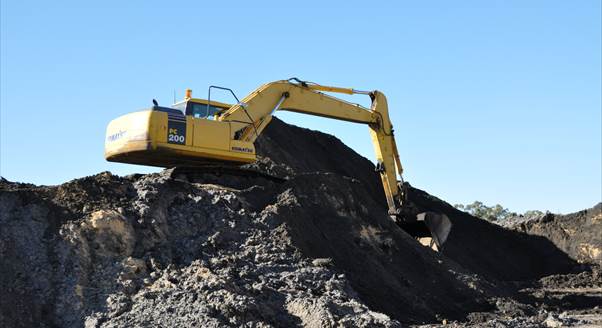
Remediation of acid sulfate peat received from Clontarf Residential Development.
Where ASS needs to be excavated, Eclipse Soils is licensed to accept and process it according to the Department of Water and Environmental Regulation Guidelines.*
Eclipse Soils aims to find the highest and best use for remediated ASS once treated and validated. These uses include structural fill and ingredients in the production of blended water retentive soils. Eclipse’ blended soil products have been scientifically demonstrated to reduce irrigation demands by up to 50% compared to a typical calcareous coastal sand or a Bassendean sand.
*Department of Environmental Regulation (2015) Treatment and Management of soil and water in acid sulfate soil landscapes. Government of Western Australia.
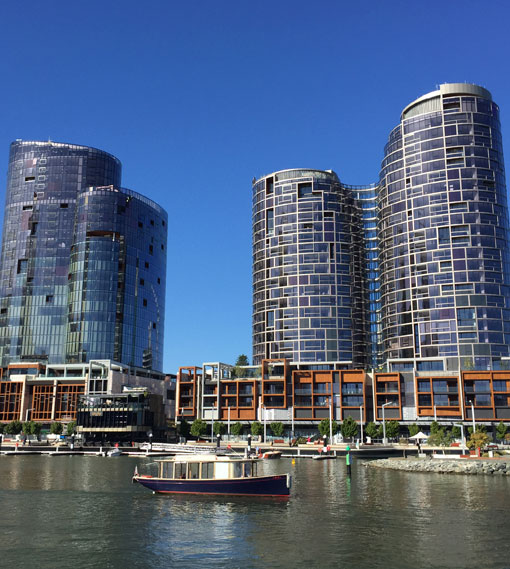
Case Study
The Towers And The Ritz-Carlton, Elizabeth Quay
Eclipse transported, received and remediated some 200,000 tonnes of Acid Sulfate Soils from the basement excavations of The Towers Project at Elizabeth Quay. The material consisted of Swan River Alluvium and Perth Formation (Guildford) Clays. The highest quality clays are used as an essential ingredient in the production of water retentive soils.
Other major acid sulfate soils projects completed:
190,000 tonnes of acidic peat excavated from the Clontarf residential development. This material was remediated and stockpiled and is currently being used in water retentive blended soil production.
750,000 tonnes of acidic peat from the Roselea Estate, City of Stirling and the IKEA site, Osborne Park were remediated to a minimum pH of 7 and used as soil supplements. Much of the material has been used on “The Kilns” residential development in Carramar where up to 1m of water retentive soil overlays inert fill material and now supports 20ha of landscaped lawns and gardens with significant water savings (see also cover photograph).
Bio- Remediation and Remediation
At Eclipse Soil’s Abercrombie Road Postans Resource Recovery Centre, soils that have been impacted with hydrocarbons (predominately diesel) and some pesticides are remediated in an impermeable HDPE fully lined and bunded cell.
Eclipse Soils is licenced for this process and its management is in compliance with the Department of Environment (2004) Bioremediation of hydrocarboncontaminated soils in Western Australia.
Historically, contaminated soils such as those from hydrocarbon spills were disposed to landfill without treatment, which is the least preferred option (EPA (2000) Guidance Statement for Remediation Hierarchy for Contaminated Land). When bioremediated, many of these soils are carbon rich and suitable for landscape use. Once treated and validated, Eclipse uses bioremediated soils in blended soil products, or as good quality fill for landscape rehabilitation.
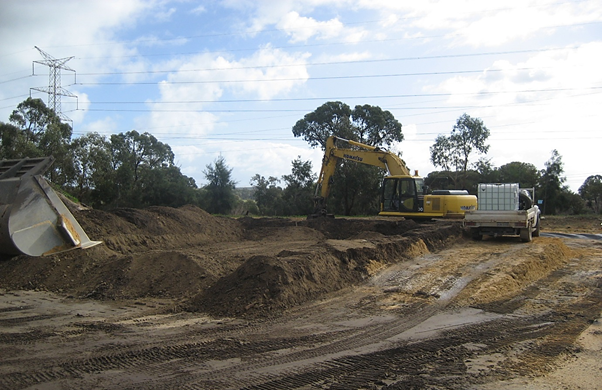
Bioremediation of hydrocarbon impacted soils in Eclipse’ Biocell.
Case Study
Diesel Tanker Rollovers, Main Roads WA
Eclipse works with first responders to aid in the clean-up of soils impacted with diesel from tanker truck rollovers. Volumes of up to 120,000L of diesel can be spilled during a single rollover, impacting up to 3,000 tonnes of soil. This soil must be removed, preferably immediately for treatment, to minimise environmental impacts.
OTHER BIOREMEDIATION PROJECTS COMPLETED:
Treatment of hydrocarbon and dieldrin impacted soils from Western Power sites throughout WA
Treatment of hydrocarbon impacted soil from the PTA marshalling yards, Leighton Beach and the former railway workshop land, Midland
Many petrol station site clean-ups for the major oil companies
Soils impacted with other Material- Complex Projects
Eclipse Soils excels in dealing with soils impacted with inert contaminants. Our team of experienced Environmental Scientists can provide solutions to complex contamination problems following the review of site environmental data or reports.
We are always happy to discuss and provide advice on any potential projects. This can be of particular advantage prior to or during the tender stage of projects, as we are frequently able to provide solutions that avoid disposal to traditional landfill and the associated high costs.
Always the aim is to divert disposal away from landfill and create a useful product that is cost effective and environmentally safe.
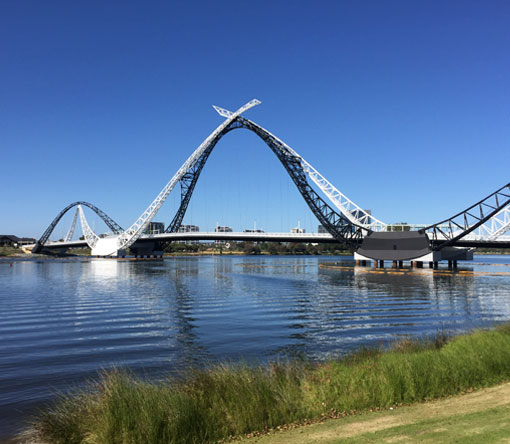
Case Study
Swan River Pedestrian Bridge (Matagarup Bridge)
Eclipse treated over 6,000 tonnes of soil impacted with leachable lead and hydrocarbons from along the East Perth Foreshore of the Swan River.
The soil posed a risk to fresh water ecosystems due to the potential for lead to leach into the Swan River. At the time of treatment, there were no other remediation or disposal options available in Western Australia.
ANOTHER EXAMPLE OF A METALS PROJECT COMPLETED:
Eclipse Soils accepted 2,700 tonnes of soil containing lead in the form of spent bullets from the clean-up of the Bushmead Rifle Range. Through customised screening processes, the lead was extracted for recycling from the soil and the soil made fit for other purposes.
Clay
It is common in the foothills and hills of Perth for clay to be excavated for construction (footings and foundations) and for infrastructure (pipelines and underground services) and replaced with sand.
Eclipse Soils accepts clay and sandy clay for stockpiling for use in blended soils products.
Case Study
Byford Secondary College
The Perth metropolitan region on the Swan Coastal Plain typically consists of hungry sands. The addition of clay and organics to Perth native sands greatly improves the nutrient retention and water holding capacity of the soil.
Green Waste
Eclipse Soils accepts green waste from vegetation clearing and site clean-up operations. Our clear preference is for woody waste from logs, branches and root stumps. Green waste should be clean from plastic, rubble and other contaminants.
Green waste is sorted, downsized and ground before being composted and pasteurised by Eclipse in accordance with Australian Standards.
Compost is then screened to separate coarse from fine material. The coarse fraction is used in long lasting mulches and the fine fraction is used as an organic component in water retentive soils.
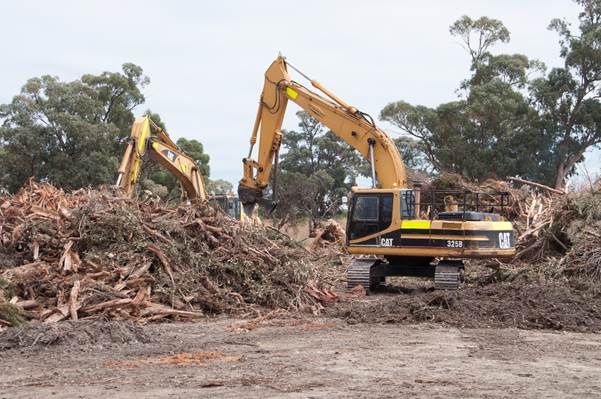
Downsizing and sorting of clean green waste prior to grinding and composting.



